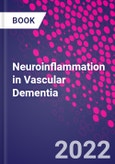Neuroinflammation in Vascular Dementia describes the molecular mechanisms that drive this transition to mixed pathology, along with the newer lifestyle and pharmacological approaches that can reduce the incidence of dementia. The book describes the practical aspects of neuroimaging methods, along with novel neuroimaging methods, using MRI, that are becoming important clinically. The author also discusses how the diagnosis of dementias will be greatly aided by biomarkers from neuroimaging, blood and CSF biochemistry and neuropsychological testing in the future. This information will be used in precision medicine to design treatment strategies based on the most likely causes of the disease.
Dementia research has undergone dramatic growth driven by current and projected increases in the aging of the population, and thus leading to a larger number of patients with dementia by 2050. Hence, advances in neuroimaging, brain chemistry, and genetics have accelerated our understanding of diseases that lead to cognitive decline.
Please Note: This is an On Demand product, delivery may take up to 11 working days after payment has been received.
Table of Contents
1. Clinical Aspects of Diagnosis2. Neuroimaging Methods
3. Role of CSF and Blood in Diagnosis
4. Classification of Subtypes of Vascular Dementia
5. Neuroinflammation
6. Animal Models Relevant to Vascular Disease
7. Molecular Pathways
8. Mechanisms of White Matter Injury
9. Machine Learning and Precision Medicine
10. Future Directions
Authors
Gary Rosenberg Professor of Neurology and Director, University of New Mexico Memory and Aging Center, Albuquerque, New Mexico, USA. Gary Rosenberg, MD is a Professor of Neurology with joint appointments in Departments of Neuroscience, Cell Biology and Physiology, and Mathematics and Statistics at the University of New Mexico. He was Chairman of Neurologybefore becoming director of the UNM Center for Memory and Aging. He is a leading authority in dementia secondary to vascular disease. He discovered the role of the matrix metalloproteinases in the brain and was the first to describe the
important role they played in disruption of the blood-brain barrier. He is an expert in neuroimaging and was one of the first investigators to use dynamic contrast-enhanced MRI to measure blood-brain barrier permeability in humans. He is currently principal investigator of one of centers in the NIH MarkVCID consortium for the study of biomarkers in vascular cognitive
impairment and the impact of vascular disease on Alzheimer's disease. He has published over 160 peer-reviewed papers and two books on brain fluids and metabolism.








